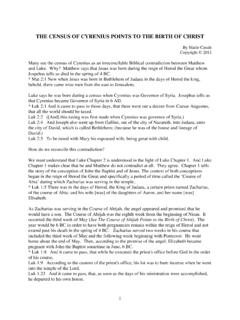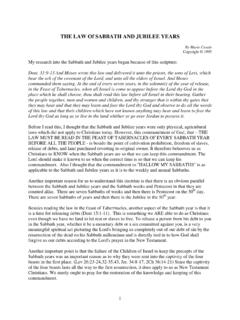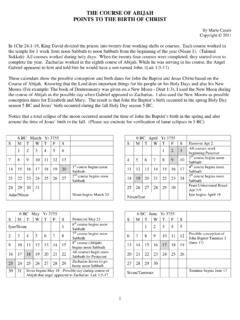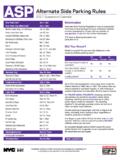Transcription of THE HEBREW CALENDAR POINTS TO THE YEAR OF …
1 1 THE HEBREW CALENDAR POINTS TO THE YEAR OF THE DEATH OF CHRIST By Marie Casale Copyright 2011 Jesus ministry began with his baptism by John the Baptist in the fall of 26 AD. He died three and a half years later in the spring of 30 AD. The Jubilee Year of 28 AD marked the middle of the ministry of Jesus, and it was also the middle of a week of seven thousand years. Seven thousand years is God s broad timetable from the creation of the world to the end of the millennial reign of Christ to work out his entire plan for mankind. The Jubilee year of 28 AD marked the four thousandth year of those seven thousand. See the Sabbath Jubilee Chart Creation To Present The Seventy Weeks Prophecy (Dan 9:24-27), written hundreds of years before Christ, reveals that Jesus would die in the middle of a week of seven years. The seventy weeks began in the year 457 BC. Sixty-nine and one-half of the Seventy weeks ended in 30 AD. See study on the Seventy Weeks Prophecy Finally, calculation of the HEBREW CALENDAR will show that Jesus died in the middle of a week of seven days.
2 THE DOCTRINE THAT THE CRUCIFIXION OCCURRED ON: FRIDAY, APRIL 3, 33 AD Most Christian churches teach that Jesus was crucified on Good Friday and rose from the dead on Easter Sunday morning. They believe Jesus died in 33 AD since in that year Passover occurred on a Friday. They see the preparation day as the day before the weekly Sabbath. They count Friday as Day 1, Saturday as Day 2 and Sunday as Day 3. 1. The doctrine of 33 AD cannot harmonize with the fact that Jesus said he would be three days and three nights in the tomb because three days and three nights cannot fit between Friday and Sunday morning. So they see what Jesus said as a metaphor, not as literal. 2. The doctrine of 33 AD cannot harmonize with the Seventy Weeks Prophecy. Sixty-nine and one-half of the Seventy weeks ended in 30 AD. 33 AD would bring the crucifixion to almost the end of the seventieth week. 3. The doctrine of 33 AD does not harmonize with the reign of Herod the Great in whose reign Jesus was born.
3 Herod died in the spring of 4 BC. Therefore Jesus was born in the fall of 5 BC. If his death were in 33 AD, this would make Jesus 36 years old. Or, to make his death at 33 years old where it is supposed to be, his birth would have to be moved up several years and past the death of Herod. (See study on Herod the Great.) (See also the study on the Star of Bethlehem that tells how some have attempted to move the date of Herod s death.) 2 4. The doctrine of 33 AD does not harmonize with the 15th year of Tiberius Caesar when Jesus was baptized at about thirty years of age. (whether you count Tiberius s co-regent years with Augustus or not) (See the study on Tiberius Caesar.) THE DOCTRINE THAT THE CRUCIFIXION OCCURRED ON: WEDNESDAY, APRIL 25, 31 AD The doctrine that prevails in many of the Churches of God today is that Jesus died on a Wednesday Passover in 31 AD. They recognize that a Wednesday Passover is important to establish that Jesus died in the middle of a week of seven days.
4 They also recognize that a Wednesay Passover is important for Jesus to fulfill his prophecy that he would be literally three days and three nights in the tomb. However, the problem with 31 AD is that according to the calculation of the HEBREW CALENDAR , it had a Monday, not a Wednesday Passover. Then why does the Church of God believe 31 AD had a Wednesday Passover? This doctrine was introduced into the Worldwide Church of God by Dr. Herman Hoeh in the 1970 s. It impressively showed a parallel between the founding of the New Testament Church (said to be in 31 AD) and the founding of the Worldwide or Radio Church of God in 1931 AD, asserting that there were exactly 100 19-year time cycles (1900 years) between the founding of the two churches. See Tomorrow s World Feb 1972 Personal From Herbert Armstrong (Vol%20IV%20No%2002)% For a detailed explanation of this doctrine, see The CALENDAR of Christ and the Apostles, by Carl Franklin, Chapter Six This doctrine changes the leap-year sequence in the calculation of the HEBREW CALENDAR .
5 The CALENDAR we use today was published by Hillel II during his tenure in the Sanhedrin 320-385 AD. It places leap years at years 3, 6, 8, 11, 14, 17 and 19 of a 19-year cycle. Dr. Hoeh introduced an intercalary cycle with leap years 2, 5, 7, 10, 13, 16 and 18 in its place for years before 142 AD when the change supposedly occurred. This change would not affect the calculation of Holy days today, but it did affect the years of Jesus. Dr. Hoeh s intercalary cycle classified 30 AD as a leap year (year 10 of the cycle having 385 days). The additional month that was added to 30 AD moved the date of Passover in 31 AD from its correct date of Monday, March 26, to Wednesday, April 25. The church members never questioned this doctrine since in general they had no knowledge about how to calculate the CALENDAR . Hence, the false assumption that the crucifixion of Christ took place on a Wednesday Passover in 31 AD persists today in the Churches of God. 3 In order to see that the calculation of 31 AD will give a Monday, not a Wednesday Passover, see Biblical Holy Day CALENDAR Calculator of the Christian Biblical Church of God and type in 31 AD.
6 (This CALENDAR calculator does use the postponement rules.) For those who would like to see the CALENDAR calculated manually, I have created a HEBREW CALENDAR Workbook for calculating 30 and 31 AD. Thus you can see the process step by step that 31 AD does calculate out to a Monday Passover. 30 AD Nisan Year 3790 30 AD March/April sun mon tues wed thurs fri sat sun mon tues wed thurs fri sat 1 2 3 23 24 25 4 5 6 7 8 9 10 26 27 28 29 30 31 1 11 12 13 14 15 16 17 2 3 4 5 6 7 8 18 19 20 21 22 23 24 9 10 11 12 13 14 15 25 26 27 28 29 30 16 17 18 19 20 21 Wednesday, Nisan 14, Passover Thursday, Nisan 15, 1st Day Unleavened Bread Wednesday Nisan 21, 7th Day Unleavened Bread Wednesday, April 5, Passover Thursday, April 6, 1st Day Unleavened Bread Wednesday, April 12, 7th Day Unleavened Bread 31 AD Nisan Year 3791 31 AD March/April sun mon tues wed thurs fri sat sun mon tues wed thurs fri sat 1 2 3 4 5 13 14 15 16 17 6 7 8 9 10 11 12 18 19 20 21 22 23 24 13 14 15 16 17 18 19 25 26 27 28 29 30 31 20 21 22 23 24 25 26 1 2 3 4 5 6 7 27 28 29 30 8 9 10 11 Monday, Nisan 14, Passover Tuesday, Nisan 15, 1st Day Unleavened Bread Monday.
7 Nisan 21, 7th Day Unleavened Bread Monday, March 26, Passover Tuesday, March 27, 1st Day Unleavened Bread Monday, April 2, 7th Day Unleavened Bread God commanded the observance of the seventh (Sabbath) day since creation. Thus, the weekly cycle of seven days has never changed throughout history. When Israel lost track of it because they were slaves in Egypt for over 400 years, the Lord revealed to them when the Sabbath day was by the miracle of the manna that fell for them to eat six days and did not fall on the seventh. (Ex 16:21-30) God also commanded the annual observances of his Holy Days (Lev 23). Since the HEBREW CALENDAR determines when those days are, it must have been safely kept since the time God revealed it to Moses until it was published by Hillel II for benefit of the Jews who were then 4 scattered all over the world. Like the weekly cycle, the CALENDAR of God cannot be the product of an evolutionary process with changeable dates set by men.
8 The strongest evidence I have found for this is the fact that dates from secular sources have been verified by the calculated HEBREW CALENDAR . Several such dates are given by Mr. Franklin in his article, The CALENDAR of Christ and the Apostles. (See above for internet address.) For example, he gives these sources that say the temple was burned on Saturday and Sunday the 9th and 10th of Ab in 70 AD. 1. Josephus records that the temple was destroyed on the 10th of Ab, the same date on which the first temple was destroyed. Josephus Wars, 6:4:5). 2. Rabbinic authorities quoted in Babylonian Talmudic Tractate Ta anith 29a record that the 10th of Ab in both cases was a Sunday. 3. Cassius Dio, a Roman historian, records that the Temple was breached on the Sabbath. Loeb Classical Library, 9 volumes, Greek texts and facing English translation: Harvard University Press, 1914 thru 1927. Translation by Earnest Cary. Cassius Dio, Roman History, Epitome of Book LXV:LXVI:4-7 _Dio/65*.
9 Html The HEBREW CALENDAR using the same intercalary cycle we use today verifies these dates. In fact, 69-70 AD is year 11 of the 19-year cycle. Year 11 is a leap year only in the intercalary cycle 3, 6, 8, 11, 14, 17 and 19. If the cycle 2, 5, 7, 10, 13, 16, and 18 were used, 70 AD would not have been a leap year and the CALENDAR dates would not coincide with the secular records. 69-70 AD Ab Year 3830 70 AD July/August sun mon tues wed thurs fri sat sun mon tues wed thurs fri sat 1 2 27 28 3 4 5 6 7 8 9 29 30 31 1 2 3 4 10 11 12 13 14 15 16 5 6 7 8 9 10 11 17 18 19 20 21 22 23 12 13 14 15 16 17 18 24 25 26 27 28 29 30 19 20 21 22 23 24 25 Destruction of Herod s temple occurred in the year 70 AD on Ab 9 and 10, Saturday and Sunday Destruction of Herod s temple occurred in the year 70 AD on August 4 and 5, Saturday and Sunday Since the sources also said that the destruction of the first temple in 585 BC occurred on the same dates, I checked the CALENDAR for that year.
10 It does verify the 9th and 10th of Ab as Saturday and Sunday 5 585-584 BC Ab Year 3177 584 BC July/August sun mon tues wed thurs fri sat sun mon tues wed thurs fri sat 1 2 17 18 3 4 5 6 7 8 9 19 20 21 22 23 24 25 10 11 12 13 14 15 16 26 27 28 29 30 31 1 17 18 19 20 21 22 23 2 3 4 5 6 7 8 24 25 26 27 28 29 30 9 10 11 12 13 14 15 Destruction of the first temple occurred in the year 585-584 BC on Ab 9 and 10, Saturday and Sunday Destruction of the first temple occurred in the year 584 BC on July 25 and 26, Saturday and Sunday 585-584 BC is year 4, a common year in both intercalary cycle 3, 6, 8, 11, 14, 17 and 19 and cycle 2, 5, 7, 10, 13, 16, and 18. However, since the online CALENDAR calculator I used calculates all years from 585 BC to 70 AD using the intercalary cycle 3, 6, 8, 11, 14, 17 and 19, this is clear evidence that the same CALENDAR we use today was used in 70 AD and also in 585 BC. This covers a span of 654 years including the years of Christ.










